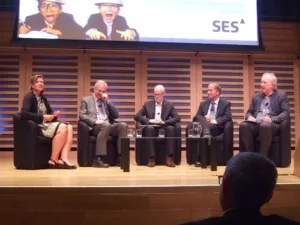Ron Martin of Panasonic, Paul Hide of TechUK, Tom Christphory of SES and Simon Fell from the EBU took part in a panel titled ‘Beyond HD: Can we deliver it, and how?’ The panel was chaired by Barbara Lang, executive director of SMPTE.
Lang asked what the definition of UltraHD is – although if the day had shown anything up to this point, it’s that nobody is quite sure!
According to Fell and the EBU, UltraHD is a mixture of resolution and other enhancements – including WCG. When he first saw it demonstrated in Japan, he thought it was only useful for some niche cases, but now he sees that it has a subtle but distinct feature. Christphory said that SES also thought that UltraHD was a natural evolution for TV – but not all factors that had been discussed are equal. Some, like HDR, provide a higher benefit, while others, like HFR, still need examination.
UltraHD is here and content is available, but limited, said Hide. Will it exist? Obviously yes, it already does – but will it be enthusiast or mainstream? The risk for the industry is UltraHD becoming an enthusiast-only format. Another challenge is monetisation, which has been difficult with HD. Martin, for his part, defined himself as an enthusiast for excellence in imagery. Two years ago, when people were shown HD and UltraHD content at IFA 2013, they couldn’t see the difference; however, the response in the same demonstration at IFA 2014 was, “Of course I can”. “We have trained the consumer vision”, he said.
If UltraHD is coming, are broadcasters ready for distribution? Fell does not think that they are yet, but that a tipping point will come when most studio equipment handles UltraHD – we are already seeing it in cameras. Currently UltraHD is difficult to transport even locally, requiring four cables.
Martin spoke about the UHD Alliance, which was announced at CES this year (Industry Stakeholders Form UHD Alliance) and formalised around NAB. It is a consortium of manufacturers and content providers, working to develop minimum technical requirements for performance. The UHD Forum operates in a similar way.
Hide noted that replacement cycles are accelerating, and so it may not be as big of a challenge as expected to get people to buy a new UltraHD set – even if they have only purchased an HD model in the last few years. Aggressive price erosion has helped to lower replacement cycles from 10 years to eight, or possibly six. Consumers are especially receptive to devices that are seen as ‘future-proof’.
Speaking about the challenges to helping SES’ clients to bring UltraHD to consumers, Christphory said that the biggest stumbling block is that broadcasters are relying on standards. A single standard, agreed by everyone in the distribution chain, is required, but putting it in place takes time. UltraHD Phase 1 (Display Monitor Vol 21 No 23) is a good start, but will need to be consistent with what follows (Phase 2 – UltraHD with ‘better pixels’). Christphory emphasised that “we cannot have two streams for two types of receivers”. He wants those working on second-phase standards (the DVB and EBU) to ensure backwards compatibility.
Fell also supported the need for a standard that is good for everyone. He said that OTT operators are currently mostly showing film content in UltraHD, using existing film standards. These could become the de facto standards if the industry does not move quickly, he warned.
Returning to image enhancements, Lang asked Hide how people should be made aware of new features like HDR. She said that most cameras these days, even on mobiles, have an HDR function, to which Hide replied that common language such as this definitely helps. He added that while people may not upgrade their TVs until they can see a clear difference between SD, HD, UltraHD etc., they will pay more for the device – the problem is how to get them to keep paying after that.
The importance of user-generated content was discussed for a short time. With the lack of UltraHD content from studios, and the availability of cameras that can shoot UltraHD images and video, consumers are the primary source of high-resolution content today.
Fell said that a timer needs to be set for UltraHD’s introduction, forcing the industry to move. SD was announced in the ’90s and HD in the mid-2000s. If UltraHD programming was announced today, it would be about four years before it was launched in sufficient scale – “let’s assume 2020”, he said.
Martin closed by saying that he expects TVs to enter the market this year with “stunning” wide colour gamut and high frame rates.

